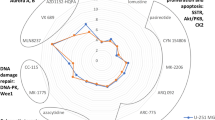Abstract
In this study mitoxantrone (Mtx) induced DNA strand breaks were measured with the alkaline elution technique in short term cell cultures derived from human gliomas. Glioblastomas or astrocytomasfrom 5 patients who underwent intracranial surgery were cultured and incubated 1 h with different concentrations of Mtx (0, 0.01, 0.1 and 1.0 μg/ml). The alkaline elution methodwas modified to measure DNA lesions in human gliomas. Mtx inducedDNA strand breaks in a dose dependent manner in all cell culturestested. There was a linear increase of DNA strand break frequencyinduced by Mtx between 0.01—1.0 μg/ml. Concerning these in vitro data, Mtx might be potentially useful for the treatment ofpatients with malignant brain tumors.
Similar content being viewed by others
References
Koeller J, Eble M: Mitoxantrone: A novel anthracycline derivative. Clin Pharm 7: 574–581, 1988
Lenk H, Müller U, Tanneberger S: Mitoxantrone: mechanism of action, antitumor activity, pharmacokinetics, efficacy in the treatment of solid tumors and lymphomas, and toxicity. Anticancer Res 7: 1257–1264, 1987
Faulds D, Balfour JA, Chrisp P, Langtry HD: Mitoxantrone: A review of its pharmacodynamic and pharmacokinetic properties, and therapeutic potential in the chemotherapy of cancer. Drugs 41: 400–499, 1991
Ehninger G, Schuler U, Proksch B, Zeller K-B, Blanz J: Pharmacokinetics and metabolism of mitoxantrone. Clin Pharmacokinet 18: 365–380, 1990
Alberts DS, Peng YM, Bowden GT, Dalton WS, Mackel C: Pharmacology of mitoxantrone: mode of action and pharmacokinetics. Invest N Drugs 3: 101–107, 1985
Bowden GT, Roberts R, Alberts DS, Peng Y-M, Garcia D: Comparative molecular pharmacology in leukemic L 1210 cells of the anthracene anticancer drugs mitoxantrone and bisantrene. Cancer Res 45: 4915–4920, 1985
Cohen LF, Glaubiger DL, Kann HE, Kohn KW: Protein associated DNA single strand breaks and cytotoxicity of dihydroxyanthracenedione (DHAD), NSC-301739, in mouse leukemia cells. Proc Am Ass Cancer Res 21: 277, 1980
Fox ME, Smith PJ: Long-term inhibition of DNA synthesis and persistence of trapped topoisomerase II complexes in determining the toxicity of the antitumor DNA intercalators mAMSA and mitoxantrone. Cancer Res 50: 5813–5818, 1990
Basra J, Wolf CR, Brown JR, Patterson LH: Evidence for human liver mediated free-radical formation by doxorubicin and mitoxantrone. Anticancer Drug Design 1: 45–52, 1985
Fisher GR, Patterson LH: DNA strand breakage by peroxidase-activated mitoxantrone. J Pharm Pharmacol 43: 65–68, 1991
Kohn KW, Ewig RAG, Erickson LC, Zwelling LA: Measurement of strand breaks and cross-links by alkaline elution. In: Friedberg EC, Hanawalt PC (eds) DNA Repair, a Laboratory Manual of Research Procedures, 379–401, 1981
Kohn KW, Grimek-Ewig RA: Alkaline elution analysis, a new approach to the study of DNA single-strand interruptions in cells. Cancer Res 33: 1849–1853, 1973
Nikkhah G, Tonn JC, Hoffmann O, Kraemer HP, Darling JL, Schönmayr R, Schachenmayr W: The MTT assay for chemosensitivity testing of human tumors of the central nervous system. Part I: Evaluation of test variables specific variables. J Neurooncol 13: 297–303, 1992
Cesarone CF, Bolognesi C, Santi L: Improved microfluorometric DNA determination in biological material using 33258 hoechst. Analytical Biochemistry 100: 188–197, 1979
Heinemann V, Murray D, Walters R, Meyn RE, Plunkett W: Mitoxantrone-induced DNA damage in leukemia cells is enhanced by treatment with high-dose arabinosylcytosine. Cancer Chemother Pharmacol 22: 205–210, 1988
Jensen PB, Vindelov L, Roed H, Demant EJF, Sehested M: In vitroevaluation of the potential of aclarubicin in the treatment of small cell carcinoma of the lung (SCCL). Br J Cancer 60: 838–844, 1989
Jones SE, Dean JC, Young LA, Salmon SE: The human tumor cologenic assay in human breast cancer. J Clin Oncol 3: 277–283, 1979
Salmon SE, Meyskens FL Jr, Alberts DS, Soehnlen B, Young L: New drugs in ovarian cancer and malignant melanoma: In vitrophase II screening with the human tumor stem cell assay. Cancer Treat Rep 65: 1–2, 1981
Dietel M, Arps H, Gerding D, Trapp M, Sieck M: Effectiveness of mitoxantrone on the proliferation of cell cultures derived from malignant mesenchymal tumors of human origin. J Cancer Res Clin Oncol 114: 197–203, 1988
Kohn KW, Erickson LC, Ewig RAG, Friedman CA: Fractionation of DNA from mammalian cells by alkaline elution. Biochemistry 15: 4629–4635, 1976
Nikkhah G, Tonn JC, Hoffmann O, Kraemer HP, Darling JL, Schachenmayr W, Schönmayr R: The MTT assay for chemosensitivity testing of human tumors of the central nervous system. Part II: Evaluation of patient-and drug-specific variables. J Neurooncol 13: 13–24, 1992
Green RM, Stewart DJ, Hugenholtz H, Richard MT, Thibault M, Montpetit V: Human central nervous system and plasma pharamcology of mitoxantrone. J Neuro Oncol 6: 75–83, 1988
Stewart DJ, Hugenholtz H, Russel N, Richard MT, Banoit B, Maroun JA, Grahavac C, Girard A, Nabwangen JF: Phase II study of Novantrone (mitoxantrone hydrochloride) in adults with grade III–IV astrocytomas. In: Walker MD, Thomas DGT (eds) Biology of Brain Tumour, Martinus Nijhoff, Boston 411–413, 1986
Author information
Authors and Affiliations
Rights and permissions
About this article
Cite this article
Senkal, M., Tonn, J., Scho¢nmayr, R. et al. Mitoxantrone-induced DNA strand breaks in cell-cultures of malignant human astrocytoma and glioblastoma tumors. J Neurooncol 32, 203–208 (1997). https://doi.org/10.1023/A:1005792410604
Issue Date:
DOI: https://doi.org/10.1023/A:1005792410604




